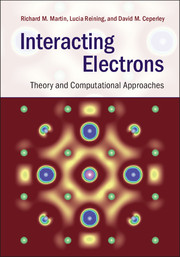Book contents
- Frontmatter
- Dedication
- Contents
- Preface
- Acknowledgments
- Notation
- Part I Interacting electrons: beyond the independent-particle picture
- Part II Foundations of theory for many-body systems
- Part III Many-body Green's function methods
- 9 Many-body perturbation theory: expansion in the interaction
- 10 Many-body perturbation theory via functional derivatives
- 11 The RPA and the GW approximation for the self-energy
- 12 GWA calculations in practice
- 13 GWA calculations: illustrative results
- 14 RPA and beyond: the Bethe–Salpeter equation
- 15 Beyond the GW approximation
- 16 Dynamical mean-field theory
- 17 Beyond the single-site approximation in DMFT
- 18 Solvers for embedded systems
- 19 Characteristic hamiltonians for solids with d and f states
- 20 Examples of calculations for solids with d and f states
- 21 Combining Green's functions approaches: an outlook
- Part IV Stochastic methods
- Part V Appendices
- References
- Index
15 - Beyond the GW approximation
from Part III - Many-body Green's function methods
Published online by Cambridge University Press: 05 June 2016
- Frontmatter
- Dedication
- Contents
- Preface
- Acknowledgments
- Notation
- Part I Interacting electrons: beyond the independent-particle picture
- Part II Foundations of theory for many-body systems
- Part III Many-body Green's function methods
- 9 Many-body perturbation theory: expansion in the interaction
- 10 Many-body perturbation theory via functional derivatives
- 11 The RPA and the GW approximation for the self-energy
- 12 GWA calculations in practice
- 13 GWA calculations: illustrative results
- 14 RPA and beyond: the Bethe–Salpeter equation
- 15 Beyond the GW approximation
- 16 Dynamical mean-field theory
- 17 Beyond the single-site approximation in DMFT
- 18 Solvers for embedded systems
- 19 Characteristic hamiltonians for solids with d and f states
- 20 Examples of calculations for solids with d and f states
- 21 Combining Green's functions approaches: an outlook
- Part IV Stochastic methods
- Part V Appendices
- References
- Index
Summary
Summary
In this chapter, shortcomings of the GW approximation are analyzed, and different ways are proposed to go beyond. The approaches fall into three broad classes: first, one can iterate Hedin's equations that link the self-energy, the polarizability, the screened Coulomb interaction, and the vertex function with the Dyson equation for the one-body Green's function. Second, one can use other Dyson equations like in the T-matrix approach, and third, one can make an ansatz for the one-body Green's function inspired by physical considerations or insight from models, in particular the idea of electron–boson coupling that leads to the cumulant expansion. Applications are given for illustration. Some more ideas and links to subsequent chapters provide an outlook.
The GW approximation is a widely used approach in computational electronic structure. However, the previous chapters show some severe limitations. One example is systems with low-energy excitations, as illustrated by the Hubbard dimer in the dissociation limit, where bonding and antibonding orbitals become degenerate. This can be seen in Sec. 11.7. Another example is satellite series, for example in the photoemission spectrum of silicon in Sec. 13.1. Moreover, even in a situation where the approximation is well justified, it induces some error, though maybe small, and one eventually wants to do better.
The full self-energy functional is in principle known: it is the Luttinger–Ward sum of skeleton diagrams derived from Eq. (11.35). However, this is an infinite sum, and no closed form of the result is known. Hence, the task is not to invent new diagrams: it is to make a choice of diagrams or combinations of diagrams, which are evaluated fully or in an approximate way. This is the framework of the present chapter. In some cases we will add diagrams to the GWA ones, which gives rise to vertex corrections; in other cases some of the GWA diagrams are neglected while different ones are taken into account. An example is the T-matrix approximation, which sums ladder diagrams instead of bubbles. In general one tries to combine this with the GWA, especially in extended systems where screening is important. Therefore the GWA plays a prominent role, and the whole chapter is called beyond GW.
The chapter contains advanced material, that is in part exploratory and refers to current research. It is intended to make links to communities outside the GW world, and to other chapters.
- Type
- Chapter
- Information
- Interacting ElectronsTheory and Computational Approaches, pp. 389 - 420Publisher: Cambridge University PressPrint publication year: 2016



